Light extraction and anti reflection
NAPA developed combination of materials and patterns in order to manage light in scintillating crystals. Sol-gel resists, which NAPA develops are power fool tools to pattern materials without the need of etching them.
Particularly, it is possible to reduce total internal reflection (TIR) and increase considerably the number of extracted photons inside high refractive crystals such as BGO and LYSO.
Light extraction and anti reflection, in the visible range can be characterized using NAPA’s own goniospectrometer and dedicated reference diagrams.
Applications are in the fields of nuclear imagery, LED, homeland security and defense applications.
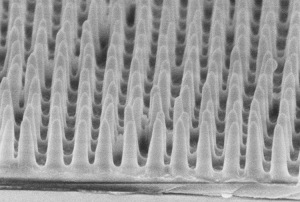
High aspect ratio sol-gel patterns for anti reflection made by NAPA
Improving PET images through photonic solutions: the Turbo-PET project
Problematic
- In a PET scanner detector, the high refractive index of the scintillator crystal causes a large number of the produced UV-vis photons to remain trapped inside the crystal: therefore up to the 70% of the light produced is not collected by the photodetector.
- The spatial resolution and the sensitivity of existing PET systems suffer from this low collection efficiency of photons.
- If monolithic crystals are used in a PET scanner, the calculation of the position of each scintillation event requires the knowledge of light transmission as a function of the angle of incidence.
- Existing simulations still hardly take into account imperfections in real system
Solution
- Light extracting layers can be deposited/fabricated on the exit surface of the scintillator crystal in order to increase the number of photons extracted.
- Measuring the angularly resolved (total) transmission experimentally by shining a laser normal to the surface of a polished half cylinder.
- Measurements before and after patterning can be done and compared to obtain the light-extraction enhancement.
- The light distribution transmitted by the exit surface can be measured for angles of incidence from -80° to 80°.
A possible light extraction layer is a nano-patterned thin film of a material with refractive index higher than the LYSO scintillator (n > 1,8): this diffraction grating is referred to as ‘photonic crystal’ (PhC).
In order to demonstrate the benefits of photonic crystals for PET imaging, the partners of the Turbo-PET project are committed to the development of a new high-resolution, high-sensitivity nuclear imaging breast PET system.
CERN and UTT develop and simulate light extracting photonic solutions. NAPA patterns the LYSO scintillating crystals blocks.
The UV-vis photons impinging the exit surface beyond the critical angle of total internal reflection (TIR) out-diffract thanks to the diffraction grating coated on the monolithic scintillator. This results in improved light extraction efficiency.
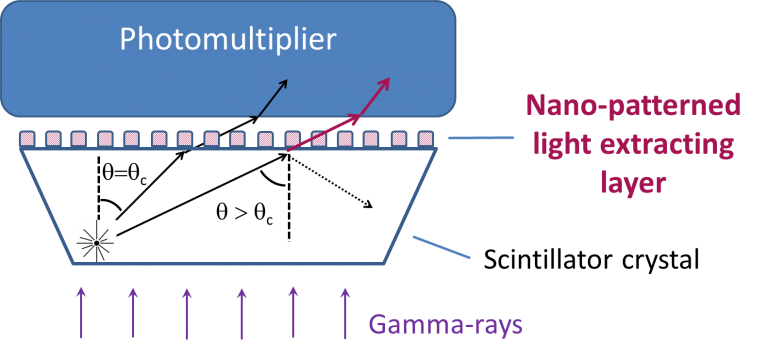
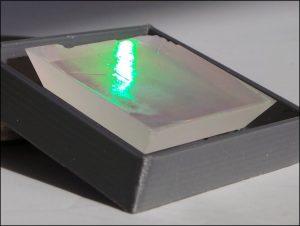
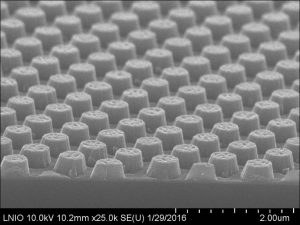
The key challenge is large scale homogeneous nano-patterning. This 5×5 cm area nano-patterning of the TiO2 layer was realized by nano-imprint lithography techniques.
Characterizations set-ups and results
The improvement in light extraction efficiency of the photonic crystal coated scintillator LYSO crystals has been measured by light yield measurements with a Cs137 radioactive source at CERN and optically, by laser-excited photoluminescence at ICD/LNIO, CNRS – Université de Technologie de Troyes
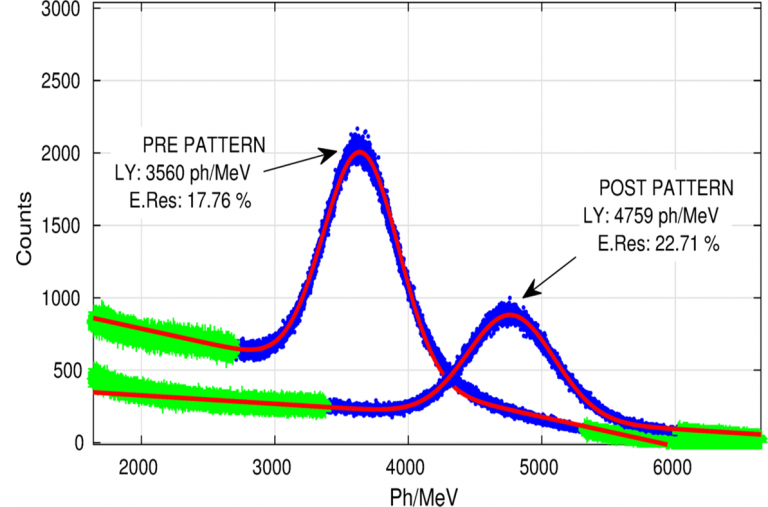
The digitized signal is analyzed and the light yield between the pre- and post-patterning characterization are compared:

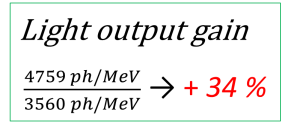

The UV-Vis photons impinging the exit surface beyond the critical angle of total internal reflection (TIR) out-diffract thanks to the diffracting patterning on the monolithic scintillator. This results in an improved light extraction efficiency of about (20 to 30% increase).
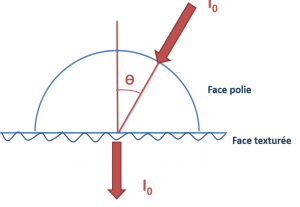
Our objective is to measure the light transmission intensity as a function of incidence angle.
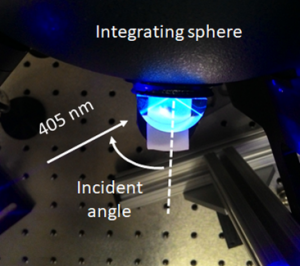
Incident angle dependent light extraction efficiency set-up.
Conclusions: Both nuclear and optical characterization methods demonstrate an improvement of the LYSO light output given by the photonic crystal. Nano-imprint makes possible the nano-patterning over large areas at a lower cost than other lithography techniques.
Although there is a lot of literature on photonic crystals, few results have been published on the characterization of photon extraction efficiency as a function of the incidence angle. Those subjects are usually treated through simulations. If photonics crystals are to be used for imaging with monolithic crystals in PET system however, the accuracy of the event location retrieval (and hence the detector spatial resolution) is very dependent on the spatial light distribution on the photo-detector. We present here a first approach of the problem using fully polished LYSO semi-cylinder and confirm the ability of the patterned face to diffract both below and beyond the critical angle, leading to a complete redistribution of the exiting photons.